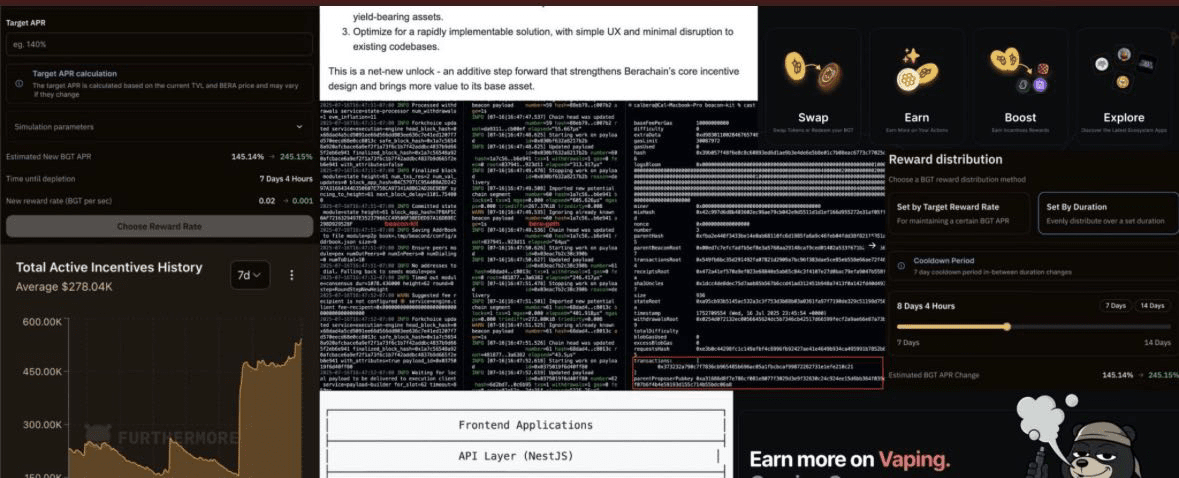🛖 BeraHub has upgraded to the on-chain control center of Berachain.
BeraHub has launched a brand new UI, improved mobile adaptation, a new portfolio page, vault one-click ZAP (single asset input, system auto-routing) feature, and an Explore Apps entry.
In simple terms, Berachain now finally has a user-facing on-chain control center covering BGT, BEX liquidity, and governance operations.
The real value lies in reducing the information burden.
Berachain and PoL are not easy to understand, and this revision of BeraHub is precisely intended to alleviate this.
To attract non-crypto native users in the future, the core flow 'Delegate BERA → Earn native income → Incentivize inflow to the dApp I use' should resemble the operations of a savings account in a bank app, rather than requiring dozens of hours to learn DeFi logic.
It is foreseeable that BeraHub will become the main entry point for CEX traffic (supporting one-click staking of BERA) and the main battlefield for builders to initiate reward activities.
💰 The Reward Vault welcomes a dual upgrade in UX and mechanism levels.
The Vault reward mechanism now supports multiple distribution models, no longer limited to a fixed cycle of linear release over N days.
APR is displayed more clearly, and users are no longer confused about when rewards will end.
Development teams can flexibly combine incentive strategies, for example: automatically increasing additional rewards when the vault reaches certain actual usage indicators.
Once the vault incentive mechanism can be programmed, it can link in real-time with on-chain KPIs:
- AMM can automatically increase rewards when slippage increases.
- Game projects can increase incentive distribution when active users decline.
- Lending protocols can automatically tighten incentives when utilization stabilizes.
In the long run, a Vault strategy market may emerge, allowing protocol parties to reuse mature incentive models (fixed interest, S-shaped release, cliff unlocking, performance-linked, etc.) like reusing AMM mathematical curves.
🔋 Governance is fully accelerated.
Guardians approved the PoL v2 native BERA income mechanism, officially listing USDT as a HONEY collateral asset and expanding the Vault incentive set.
The BGT Vault is still in operation, but now one-third of the incentives flow into the BERA staking vault, a protocol-level risk-free return rate that CeFi, project vaults, and individual users can easily understand and utilize.
The combination of USDT collateral + BERA staking income builds a bridge for off-chain funds: they can leverage stablecoins, use BERA staking to gain underlying income, and view BGT as an optional income accelerator.
More importantly, the visible RFR calibrated in the gas token (BERA) forms a market mechanism: any dApp providing income must outperform BERA staking after risk adjustment, otherwise users will naturally migrate.
This healthy market mechanism is much healthier compared to gambling APR.
🧰 The Enshrinement mechanism has initially unfolded.
Berachain is migrating to BeaconKit, which means that the core mechanism of PoL will be deeply integrated into the protocol layer itself, with economic mechanisms directly written into the client.
- Fewer off-chain records.
- A fairer validator selection mechanism (reward weight replacing proposer probability).
- Higher validator cap.
Although Enshrinement raises the threshold for protocol changes (making rapid iteration difficult), it greatly reduces combination risks and governance attack surfaces.
It is expected that Berachain will freeze a minimum viable PoL core specification and standardize extension interfaces (e.g., orchestrating incentive asset lists, fixed incentive tracks).
Once successful, subsequent forks will replicate technical specifications rather than a pile of contracts.
🔮 So, what does all this mean?
As BeraHub integrates staking, Vault, project discovery, and other operational pathways, the cost of entry for users is greatly reduced, while advanced users can still retain fine-grained control capabilities.
This is a prerequisite for implementing the CEX one-click 'Stake BERA' button and also paves the way for abstract wallet experiences (automatically using native earnings to offset Gas).
A chain can directly display 'What is the annualized return on the assets you hold?' This not only facilitates dissemination but also integration.
PoL binds incentive weights to liquidity outcomes, meaning market depth inversely affects validator income.
The mechanism of Enshrinement removes the failure risks that may arise from the adaptation layer, making block rewards more predictable, more attractive to professional validators, and simplifying the accounting model (rewards are distributed directly in BERA rather than a pile of application tokens).
This also aligns with the official documentation's definition of PoL: as an extension of PoS, PoL recalibrates the economic incentives between validators, applications, and users.
Berachain believes the next wave of adoption will come from economic comprehensibility.
A protocol layer with a risk-free return rate; a standardized incentive operating system; an official portal that can be used with one click—this is the underlying design that can be invoked by product-level developers.
In summary, Berachain is advancing a series of upgrades aimed at making user experience simpler.
Whether you are a newcomer to the crypto world or a developer looking to build the next generation of applications on Berachain.


